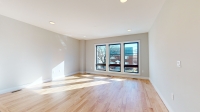Something is dripping
That is really quite interesting. While the AC unit will produce condensation, it typically drains out of the back the unit as it hangs outside the window. Whats surprising is that it is creating so much water, and that it is coming back into the wall and ceiling. Ours drip, but I guess i never considered how much water it produces.
Is it easy to pull the unit? If you can, check to see if there is a drain plug under the back corner of the unit. Maybe a black plastic or rubber plug. Try removing that first and see if it stops leaking into the room. The other thing you might check is if the angle of the unit is leaning away from the house, or tilted into the room?
It should tilt away.
rowerg has the right idea ... the ac should be tilted away from the room, if it is not then the water may backup into the room/wall ...
I do not remember seeing a plug, but I'll check. I also don't remember a night as humid as this one!
Window units produce a surprising amount of condensate. I agree with rowerg that either a drain is clogged or the unit is not properly tilted to the outside.
Because of the (horrible) vinyl replacement windows, our bedroom AC unit can't always be tilted enough towards the outside (it does, but not always enough on a real humid night): I use a rolled up towel on the widow ledge to absorb anything and check it every morning so the wood doesn't rot.
Running a hose out of the bottom of the ac unit will redirect where the condensation goes
musicmz- A word of warning about placing a large window unit in a vinyl casement without support, it can bend or mishap the bottom section, making for poor air seal come winter along that edge.
We use wooden shims under our larger units to provide support and a flat piece of metal along the front of the bottom edge of the window sash to keep the AC from pulling them out of alignment. I realized the issue after i had to replace one of our inserts that was always leaking air during winter.
What is the proper degree of tiltage? I haven't located any plugs or discharge vents on any of my very small units, but condensation is almost certainly the problem.
Is there water under the window unit at the bottom of the window opening? If there is and there is no clogged plug, then the facing outward side of unit may have to be out further past the sill.
I know nothing about air conditioners, but "tiltage" is my new favorite word.
rowerg said:
musicmz- A word of warning about placing a large window unit in a vinyl casement without support, it can bend or mishap the bottom section, making for poor air seal come winter along that edge.
We use wooden shims under our larger units to provide support and a flat piece of metal along the front of the bottom edge of the window sash to keep the AC from pulling them out of alignment. I realized the issue after i had to replace one of our inserts that was always leaking air during winter.
A piece (or two) of 2x4 in the well will solve this. The A/C will sit on the wood, not the window edge. You'll need to seal it a little better but it works well. See page 1 of the attached manual. It has information about using wood in the frame:
http://s3.amazonaws.com/szmanuals/d83527ada80653b42ff521006fc837d3
This one (page 4) discusses tilt:
http://manuals.frigidaire.com/prodinfo_pdf/Edison/2020211A2579.pdf
Concur its about how its placed/tilted.
One year, my spouse did not check on of the window units after reinstalling for season. Below it was a vintage luggage case storing beautiful scarves, evening bags, etc. It ended up "catching" all the water. Everything inside was ruined, and because it caught the water, we never saw the problem till I went to move the luggage- impossible due to the amount of water/weight. Over $3k of possessions, tossed, some vintage.
Lesson learned about checking and rechecking on "tiltage"
truegrid said:
Concur its about how its placed/tilted.
One year, my spouse did not check on of the window units after reinstalling for season. Below it was a vintage luggage case storing beautiful scarves, evening bags, etc. It ended up "catching" all the water. Everything inside was ruined, and because it caught the water, we never saw the problem till I went to move the luggage- impossible due to the amount of water/weight. Over $3k of possessions, tossed, some vintage.
Lesson learned about checking and rechecking on "tiltage"
OUCH. Sorry for the loss, truegrid. I would have been devastated.
J_R, no advice other than what has already been given, but I agree about the "tiltage" as the culprit. Any tilt that makes it lean to the outside should be enough. The angle doesn't have to be extreme.
Featured Events
-
Stephen Whitty Presents - Hometown Movie Stars: The Celebrated Actors Of CHS
May 6, 2024 at 7:00pm




























A wall in my living room had evidence of a roof leak. I replaced the ancient roof about a year ago. Since then I have not noticed any leakage until now.
There is a window AC unit directly over the spot of the former (?) leak, and when I run the AC water drips through the ceiling plaster onto the living room floor (or bucket placed thereon).
My first thought is to move the AC unit, of course. But why is it dripping water? Do I call the roofer back? Can I ever paint the living room?